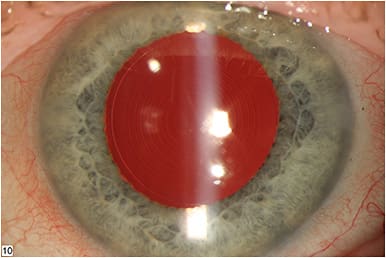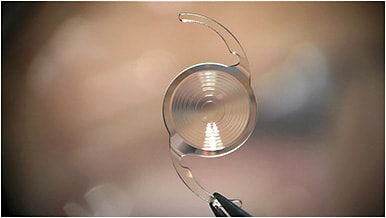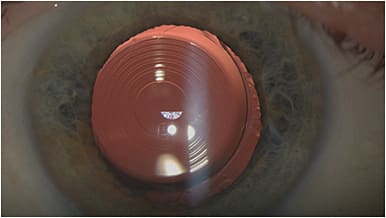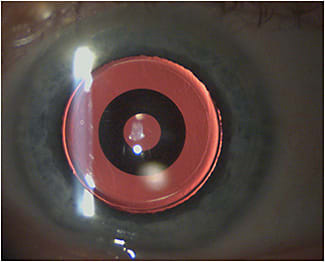Over the last few years, several new IOLs have been introduced across the globe. Many of these designs are released in Europe then follow in the United States. Once they come to the market, surgeons and patients are able to take advantage of the lenses.
Particularly noteworthy are attempts to employ cataract surgery to treat presbyopia, often called “the final frontier in refractive surgery.” This will become ever more important with the changing lifestyles in our time and the continued rise of digital equipment use like laptops, tablets and smartphones — even by elderly people.1 These circumstances contribute to an increasing importance of good near and intermediate vision), especially as some have been forced to stay home during the pandemic. In particular, an intermediate distance of about 60 cm (approximately 23 inches) plays an essential role in a daily life shaped by these electronic devices.
IOL development is an ongoing process. This evolving category is producing previously unimaginable technology, such as IOLs that can be turned from monofocal to multifocal or vice versa, or even IOLs that measure intraocular pressure with encouraging initial clinical results.2
While the future — to quote the famous “Doc” Emmett Brown — has not yet been written, we should “make it a good one,” so let’s turn to IOLs that have already proven successful in our clinic with a focus on those that are new or may be coming soon to the United States.
AT LISA
One option to provide good vision in all three distances (far, intermediate, near) are trifocal IOLs. While the Alcon PanOptix IOL was the first trifocal approved in the United States in 2019, one of the first trifocal lenses introduced in Europe in 2012 was the AT LISA tri 839MP (Carl Zeiss Meditec), which is not yet available in the United States. It is a single-piece, UV filtering, diffractive trifocal lens; its near addition is +3.33 D, intermediate vision (in this case defined as about 80 cm) is provided by an addition of +1.66 D. The light distribution across the three foci is 50% for distance, 20% for intermediate and 30% for near vision. Its optical effect is practically independent of the pupil diameter.3
In our experience and as reported in the literature, AT LISA performs well at distance and near vision.4 Trifocal IOLs come with certain photopic phenomena like glare and halos as well as a reduced contrast sensitivity, but most patients after a certain adjustment period tolerate these well. Long-term results over 6 years as published by Fernandez et al were even better than those reported 12 months postoperatively in some studies, with impressive mean uncorrected visual acuities of 0.01 logMAR for distance, 0.02 logMAR for intermediate and 0.04 logMAR for near.5
Our colleagues from Heidelberg University and Seoul have investigated an innovative way to combine the strengths of the AT LISA with that of an extended depth of focus (EDOF) IOL (in this case, the AT LARA 829MP) by implanting the EDOF IOL in the dominant eye and the trifocal IOL in the non-dominant eye. At 6 months postoperatively, the visual outcomes were better with this combination than the monocular visual acuity results achieved with each of these two different IOL designs. All patients achieved a binocular UDVA and UIVA of 0.1 logMAR and were spectacle-independent on these distances; only 4% of patients needed glasses for reading. The photic phenomena were described by Song et al as minimal.6

VIVITY
The rational behind the development of EDOF lenses is to provide spectacle-independence, particularly for the computer/intermediate and the reading/near distance, as well as to reduce the optic phenomena common in trifocal IOL use. Some EDOF lenses, though, tend not to produce significantly less visual disturbances than trifocal IOLs. Correcting the consequences in particular of presbyopia is the aim of the AcrySof IQ Vivity (Alcon) EDOF IOL. The Vivity is based on proprietary wavefront shaping (X-WAVE) technology to produce an extended focal length. It is a one-piece posterior chamber IOL with ultraviolet protection and a blue light filter. The optical zone has a 6-mm diameter and a modified central zone of 2.2-mm in diameter to produce the so-called stretched wavefront.
In a study by Gundersen and Potvin, 40 patients (average age of 59 years) had the Vivity implanted bilaterally. The colleagues from Norway reported excellent visual results at all relevant distances with a mean of logMAR -0.07 at distance (4 m or about 13 feet), logMAR 0.00 at 66 cm and logMAR 0.07 at 40 cm. Frequency of optic disturbances (halos, glare and starburst) was described by 93% of patients as “never” or “occasionally.” Hazy and blurred vision were the most commonly described optical phenomena.7 We are getting similar results with the Vivity IOL at the University Eye Hospital in Bochum, but it is too early to confirm so far.
TECNIS SYNERGY
The recently introduced Tecnis Synergy (Johnson & Johnson Vision) combines the diffractive technology of the manufacturer’s multi(bi-)focal IOL (the Tecnis) and the Tecnis Symfony with its ChromAlign technology. A sharper focus by this new IOL design combination is achieved via correction of corneal chromatic aberrations.
The lens is designed to deliver a full range of vision with a peak at distance and with fewer so-called gaps in vision than trifocal lenses. Clinical results of the Tecnis Synergy are impressive. It seems that the vision provided by this lens is less dependent on the pupil size than is the case with trifocal IOLs.2


IC-8
Over the last couple years, we have acquired immense clinical experience with a completely different concept of correcting presbyopia. The concept dates back to the early 17th century when scientist-theologian Christoph Scheiner described the pinhole as a means of improving vision for myopes. Small-aperture optics have been employed in corneal implants to correct presbyopia for some time and with varying success. One example, the Raindrop corneal inlay (Revision Optics), was recalled in 2019 after a high percentage of patients showed corneal haze.
The IC-8 (AcuFocus) is a single-piece hydrophobic acrylic IOL that applies the small-aperture principle and is implanted in the capsular bag. Its total diameter is 12.5 mm; the embedded mask, created by more than 3,000 micro-perforations, has an outer diameter of 3.23 mm and a central opening of 1.36 mm in diameter. The lens is usually implanted in the nondominant eye with a slightly myopic target refraction like -0.75 D, whereas for the partner eye — if cataract surgery is performed on both eyes — that receives usually a monofocal or multifocal IOL, emmetropia is intended. The IC-8 comes with a specifically designed injector that requires a corneal incision of 3.5 mm.
Our clinical experience with the IC-8 is very positive. In a prospective case series that we conducted at Bochum University Eye Hospital with 11 other clinics in Europe, 105 patients received an IC-8 in one eye and an aspheric monofocal IOL in the fellow eye. Six months after surgery, 99%, 95% and 79% of patients achieved 20/32 or better binocular uncorrected distance, uncorrected intermediate and uncorrected near visual acuity, respectively. The vast majority of patients (95.9%) declared that they would choose the procedure again if given the choice. The small-aperture IOL can eliminate up to 1.25 D of astigmatism.8
We also implanted the small-aperture IOL bilaterally in several patients who, 3 months after surgery, achieved better uncorrected intermediate and near vision than a monolateral control group. Six months after surgery, we observed the same trend but without statistical significance. The level of near visual acuity achieved with the bilateral approach of the IC-8 IOL was comparable with the level reported with different multifocal IOLs. However, higher scores for halos were reported in the bilateral group.9
Although some concern has been expressed that the mask could be an obstacle to vitreoretinal surgery — should such an intervention become necessary in an eye with a small-aperture IOL — our experience does not support this. We were able to perform vitrectomies in IC-8 eyes for the treatment of retinal detachment and diabetic retinopathy, as well as for membrane peeling.
AcuFocus received an Approvable Letter from the FDA for the IC-8 in December 2021 and estimates FDA approval in Q2 2022.

CONCLUSION
It might only be a matter of time until more of the IOL innovations available in Europe receive approval in the United States and our American colleagues and friends can broaden their choices to provide patients with a variety of IOL designs. There is no doubt that IOL developments will continue, and the future is bright for the enterprising cataract and refractive surgeon. OM
REFERENCES
- Boot WR, Charness N, Czaja SJ, et al. Computer proficiency questionnaire: assessing low and high computer proficient seniors. Gerontologist. 2015;55:404-411.
- Dick HB, Gerste RD. Future intraocular lens technology. Ophthalmology 2021; 128:e206-e213.
- Sudhir RR, Dey A, Bhattacharrya S, Bahulayan A. AcrySof IQ PanOptix intraocular lens versus extended depth of focus lens and trifocal intraocular lens: a clinical overview. Asia Pac J Ophthalmol 2019; 8:335-349.
- Esteve-Taboada JJ, Dominguez-Vicent A, Del Aguila-Carrasco AJ, et al. Effect of large apertures on the optical quality of three multifocal lenses. J Refract Surg. 2015;31:666-676.
- Fernández J, Rodríguez-Vallejo M, Martínez J et al. Long-term efficacy, visual performance and patient reported outcomes with a trifocal intraocular lens: a six-year follow-up. J Clin Med. 2021; 10:2009.
- Song JE, Han SY, Khormania R et al. Clinical outcomes of combined implantation of an extended depth of focus IOL and a trifocal IOL in a Korean population. J Ophthalmol. 2021; 2021:9034258.
- Gundersen KG, Potvin R. Clinical outcomes and quality of vision associated with bilateral implantation of a wavefront shaping presbyopia correcting intraocular lens. Clin Ophthalmol 2021; 15:4723-4730.
- Dick HB, Piovella M, Vukich J, et al. Prospective multicentre trial of a small-aperture intraocular lens in cataract surgery. J Cataract Refract Surg. 2017;43:956-968.
- Dick HB, Elling M, Schultz T. Binocular and monocular implantation of small-aperture intraocular lenses in cataract surgery. J Refract Surg. 2018;34:629-631.










